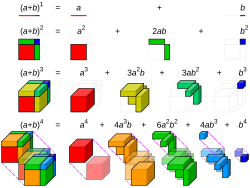Pascal's triangle
1 1 1 1 2 1 1 3 3 1 1 4 6 4 1 1 5 10 10 5 1
Pascal's Triangle is a triangular array. It is named after French mathematician Blaise Pascal, but it was known in China, Persia, and India long before Pascal was born.[1]
Pascal's triangle can be made as follows. On the first row, write only the number 1. Then, to get the numbers of following rows, add the number that can be seen above and to the left (if any) and the number above and to the right (if any) to find the new value. For example, the numbers 1 and 3 in the fourth row are added to make 4 in the fifth row.
The triangle displays the coefficients that occur when the binomial [math]\displaystyle{ (a+b) }[/math] is raised to the [math]\displaystyle{ n^\text{th} }[/math] power: [math]\displaystyle{ \begin{array}{lc} (a+b)^0= & {\color{Red}\boldsymbol{1}} \\ (a+b)^1= & {\color{Red}\boldsymbol{1}}a+{\color{Red}\boldsymbol{1}}b \\ (a+b)^2= & {\color{Red}\boldsymbol{1}}a^2+{\color{Red}\boldsymbol{2}}ab+{\color{Red}\boldsymbol{1}}b^2 \\ (a+b)^3= & {\color{Red}\boldsymbol{1}}a^3+{\color{Red}\boldsymbol{3}}a^2b+{\color{Red}\boldsymbol{3}}ab^2+{\color{Red}\boldsymbol{1}}b^3 \\ (a+b)^4= & {\color{Red}\boldsymbol{1}}a^4+{\color{Red}\boldsymbol{4}}a^3b+{\color{Red}\boldsymbol{6}}a^2b^2+{\color{Red}\boldsymbol{4}}ab^3+ {\color{Red}\boldsymbol{1}}b^4 \\ \end{array} }[/math]
The same triangle can also be expressed using combinations:
[math]\displaystyle{ \begin{array}{c} {\color{Red}\boldsymbol{1}}=\binom{0}{0} \\ {\color{Red}\boldsymbol{1}}=\binom{1}{0} \quad\quad{\color{Red}\boldsymbol{1}}=\binom{1}{1} \\ {\color{Red}\boldsymbol{1}}=\binom{2}{0} \quad\quad {\color{Red}\boldsymbol{2}}=\binom{2}{1} \quad\quad{\color{Red}\boldsymbol{1}}=\binom{2}{2} \\ {\color{Red}\boldsymbol{1}}=\binom{3}{0} \quad\quad {\color{Red}\boldsymbol{3}}=\binom{3}{1} \quad\quad {\color{Red}\boldsymbol{3}}=\binom{3}{2} \quad\quad\quad\quad {\color{Red}\boldsymbol{1}}=\binom{3}{3} \\ {\color{Red}\boldsymbol{1}}=\binom{4}{0} \quad\quad {\color{Red}\boldsymbol{4}}=\binom{4}{1} \quad\quad {\color{Red}\boldsymbol{6}}=\binom{4}{2} \quad\quad {\color{Red}\boldsymbol{4}}=\binom{4}{3} \quad\quad {\color{Red}\boldsymbol{1}}=\binom{4}{4} \\ \end{array} }[/math],
where [math]\displaystyle{ \binom n k =\frac{(n)(n-1)\ldots (n-k+1)}{(k)(k-1)\ldots (1)}=\frac{n!}{(k!)\cdot(n-k)!} }[/math]
Uses of Pascal's triangle
The triangle has many uses in probability. It can also be used in binomial expansions. For example,
- (x + 1)2 = 1x2 + 2x + 12.
Notice the coefficients are the third row of Pascal's triangle: 1, 2, 1. In general, when a binomial is raised to a positive integer power we have:
- (x + y)n = a0xn + a1xn−1y + a2xn−2y2 + … + an−1xyn−1 + anyn,
where the coefficients ai in this expansion are precisely the numbers on row n + 1 of Pascal's triangle; in other words,
- [math]\displaystyle{ a_i = {n \choose i}. }[/math]
Pascal's rule
Formally speaking, the way of making the Pascal's Triangle uses Pascal's rule, which states that
- [math]\displaystyle{ {n \choose k} = {n-1 \choose k-1} + {n-1 \choose k} }[/math]
for non-negative integers n and k where n ≥ k and with the initial condition
- [math]\displaystyle{ {n \choose 0} = {n \choose n} = 1. }[/math]
Complicated structures based on Pascal's triangle
Pascal's triangle generalizes readily into higher dimensions. The three-dimensional version is called Pascal's pyramid or Pascal's tetrahedron. A higher-dimensional analogue is generically called a "Pascal's simplex"*. See also pyramid, tetrahedron, and simplex.
Properties of Pascal's Triangle
The first and last number in each row is always 1.
- [math]\displaystyle{ {n \choose 0} = {n \choose n}=1 }[/math]
The second number in each row is the row number. In a binomial expansion, this second number is equal to the power. (This makes the 'first' row, 1, actually the zero row).
- [math]\displaystyle{ {n \choose 1} = n }[/math]
The rows always read the same forward and backward.
- [math]\displaystyle{ {n \choose k} = {n \choose n-k} }[/math]
The sum of the numbers in each row is double the sum of the numbers in the row before. The sum of each row is 2n.
- The zero row, 1, has a sum of 1.
- [math]\displaystyle{ 1=2^0=1 }[/math]
- The first row, 1,1 has a sum of 2.
- [math]\displaystyle{ 1+1=2^1=2 }[/math]
- The second row, 1,2,1 has a sum of 4.
- [math]\displaystyle{ 1+2+1=2^2=4 }[/math]
- The third row, (1,3,3,1) has a sum of 8.
- [math]\displaystyle{ 1+3+3+1=2^3=8 }[/math]
- The sum of the nth row is [math]\displaystyle{ 2^n }[/math]
- [math]\displaystyle{ \sum_{i=0}^n {n \choose i} = 2^n }[/math]
Pascal's Triangle Media
Pascal's version of the triangle
The numbers of compositions of n+1 into k+1 ordered partitions form Pascal's triangle.
Derivation of simplex numbers from a left-justified Pascal's triangle
Fibonacci sequence in Pascal's triangle
A level-4 approximation to a Sierpiński triangle obtained by shading the first 32 rows of a Pascal triangle white if the binomial coefficient is even and black if it is odd.
References
- ↑ Willers, Michael (2021). Mathematics: From Algebra to Algorithms, Adventures in Numbers. London, UK: New Burlington Books. p. 130. ISBN 978-1-80242-020-3.
Other websites
| Wikimedia Commons has media related to Lua error in Module:Commons_link at line 62: attempt to index field 'wikibase' (a nil value).. |
- Higher Dimensional Pascal's Triange - Like Structures Archived 2015-10-11 at the Wayback Machine









